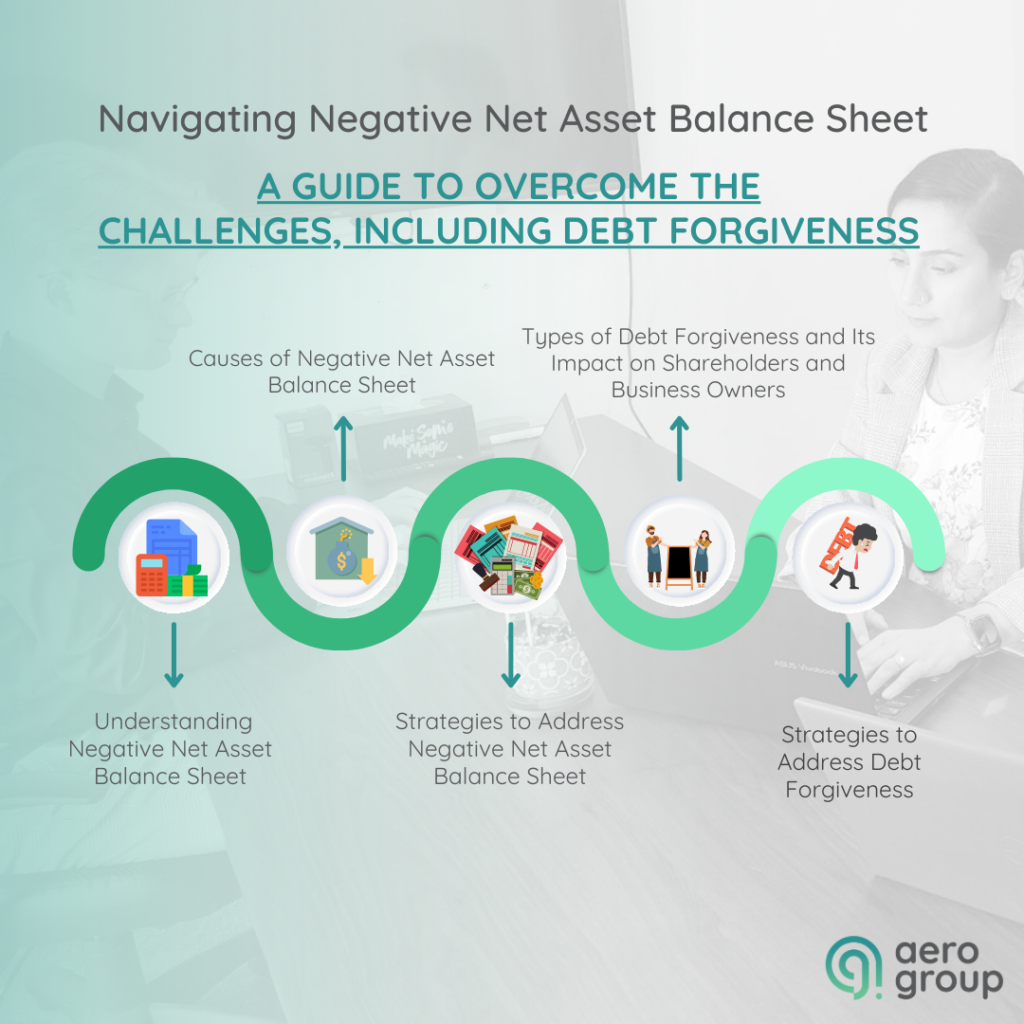- aerogroup
- March 22, 2023
- 1:55 pm
- No Comments
Navigating Negative Net Asset Balance Sheet – A Guide to Overcome the Challenges, Including Debt Forgiveness
As a business owner or financial manager, you may face a negative net asset balance sheet situation where your company’s liabilities exceed its assets. This situation can occur due to several reasons including:
- declining revenues
- increased expenses
- and loss in investment value
However, the situation can be even more complicated when debt forgiveness comes into the picture. In this article, we’ll discuss how debt forgiveness affects business owners and shareholders in terms of taxes and dividends and what they can do to address the situation.

Step 1: Understanding Negative Net Asset Balance Sheet
A negative net asset balance sheet is a financial situation where a company’s liabilities exceed its assets. It can affect a company’s creditworthiness, and lenders may hesitate to lend money which stunts the company’s ability to scale and grow.
Step 2: Causes of Negative Net Asset Balance Sheet
Several factors can cause a negative net asset balance sheet:
- high debt-to-equity ratio
- declining market value of assets
- decreasing revenues
- increasing expenses.
Identifying the key causes to each business is crucial to develop a plan to address the situation effectively.
Step 3: Strategies to Address Negative Net Asset Balance Sheet
In order to address a negative net asset balance sheet, it’s essential to evaluate the company’s financial position thoroughly and conscientiously. This includes assessing cash flow, reducing expenses, and increasing revenues. Strategies that can help include:
- Identifying and eliminating unnecessary expenses: This involves cutting back on expenses that do not contribute to the company’s growth or profitability.
- Reevaluate pricing strategy: Reassessing the pricing strategy can help increase revenue and improve cash flow.
- Renegotiate with creditors: Renegotiating payment terms with creditors can help reduce the burden of debt and improve cash flow.
- Sell unprofitable assets: Selling unprofitable assets can help reduce liabilities and improve the balance sheet.
Step 4: Types of Debt Forgiveness and Its Impact on Shareholders and Business Owners
Debt forgiveness is a process where a creditor agrees to forgive or cancel the debt owed by a borrower. The most common types of debt forgiveness include:
- Cancellation of debt by a creditor: The creditor cancels the debt owed by the borrower, and the borrower does not have to repay it.
- Debt settlement: The borrower and creditor agree on a reduced amount that the borrower will pay instead of the full debt owed.
- Loan modification: The borrower and creditor agree to change the terms of the loan to make it easier for the borrower to repay the debt.
While debt forgiveness may provide relief to the company, it can also have implications for shareholders and business owners. Debt forgiveness is considered taxable income, and the company must report it as such. This can affect the company’s ability to issue dividends to shareholders, as it must pay taxes on the forgiven debt first. Business owners may also face personal tax liabilities for the forgiven debt.
Step 5: Strategies to Address Debt Forgiveness
To address the implications of debt forgiveness, business owners and shareholders can consider the following strategies:
- Work with a tax professional: A tax professional can help develop a tax plan to minimize the tax impact of debt forgiveness.
- Explore debt restructuring: Instead of debt forgiveness, debt restructuring can help improve the company’s financial position while minimizing the tax implications.
- Consider equity financing: Equity financing, such as issuing stocks, can help raise funds without incurring debt and can also provide tax benefits.
Overcoming a negative net asset balance sheet situation can be a challenging and complicated situation for businesses to navigate, especially when debt forgiveness is involved but it’s essential to develop a comprehensive plan to address it effectively.
If you need help navigating through the complexity of negative net asset balance sheets and debt forgiveness, Reach out to Aero Accounting Group and let our Trusted Expert Accountants help sail you through the rough currents and onto calmer waters today.
Need help?
Contact us today and let us help you navigate through the complexity of negative net asset balance sheets and debt forgiveness
On ESOPs and Trusts: What Is Best Practice?
ESOPs and Trusts, what is what? Read on to find...
Read MoreGST Margin Scheme: A Guide for Property Developers
As a propety owner are you still unsure about your...
Read MoreEssential Tax Deductions: A Strategic Guide for Hospitality Owners
Utilise these strategic tax deductions for your business!
Read MoreEssential Tax Deductions: A Strategic Guide for Hospitality Owners
Don't miss out on eligible tax deductions for your business!...
Read More








